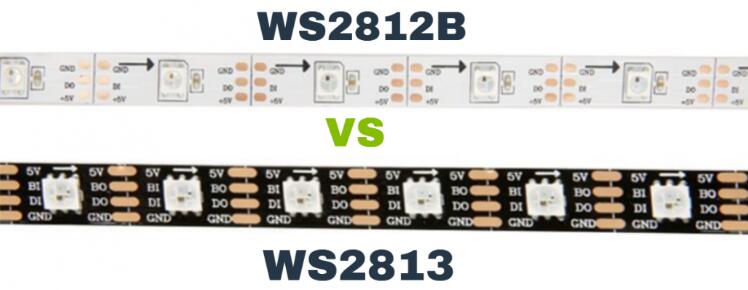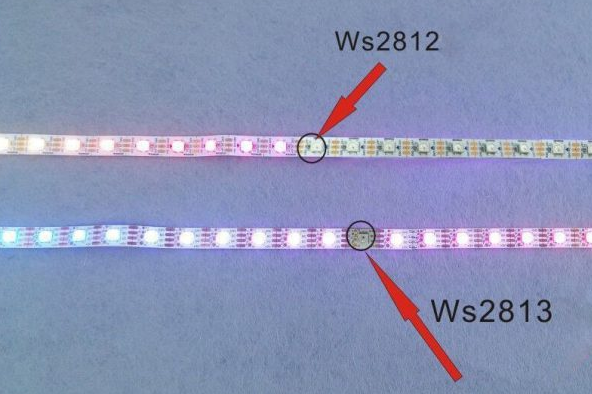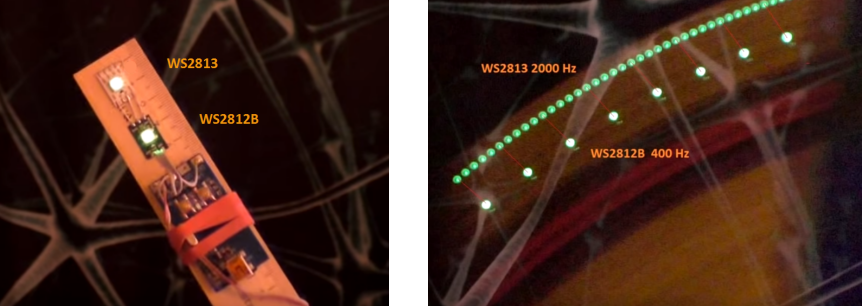The differences of WS2812B and WS2813
Release time:2019/4/19 16:40:04
Below is WS2812B and WS2813 LED strip picture;

The WS2812B RGB pixel LEDs is no doubt an immensely popular product and a beloved mainstay of every maker’s outdoor lighting projects, given its low driving voltage, high brightness and good color consistency among many advantages. An improved version of the WS2812, the WS2812B is an intelligent control LEDs light source, with the control circuit and RGB chip integrated directly into a 5050 RGB LEDs. As a digital LEDs strip, each addressable LEDs has an integrated driver that allows the brightness and color of each LED to be controlled individually, that is, one LEDs can be a different color to the one next to it. Thus, it enables us to create beautiful and complex lighting effects.
what is WS2813 pixel LEDs? Newstar's WS2813 RGB LEDs is an updated type of the WS2812B, similar to how the WS2812B is an improved version of the WS2812. Like the WS2812B LEDs, it also has a control circuit and RGB chip integrated into a 5050 RGB LEDs and each LEDs can be individually controlled. But as a relatively new version, how does the Newstar's WS2813 stack up against its popular predecessor, the WS2812B? As an improved version, we would expect advantages over the WS2812B in certain areas. Without further ado, let’s dive into some differences between the WS2812B and Newstar's WS2813.
1. What’s the main difference between the WS2812B and the WS2813?

PS:The remaining WS2813 LEDs will work normally, although have o
The most significant difference between the two LED strips is their LEDs bypass property. One of the biggest advantage that Newstar's WS2813 pixel LEDs has over the WS2812B is that it is a dual-signal wires version, with signal break-point continuous transmission. That is, if one LED in the middle of the chain burns, the circuit remains closed and the other LEDs will still light up. As long as no other adjacent LEDs are broken, the remaining LEDs will continue to work normally. When one LED is broken or burnt in a WS2812B strip, the circuit is broken and the other LEDs after in the chain will not work.
This is because the WS2812B LEDs has only one data signal, and a broken LED would prevent the other LEDs from working. However, Newstar's WS2813 LEDs have 2 data signals which mean that any pixel failure in the chain will not affect the signal transfer unless 2 adjacent LEDs are damaged. If only one LED doesn’t work then it’s not so bad. The rest can continue flashing as usual while you contemplate repairs. As such, Newstar's WS2813 LEDs are the more dependable LED strip, making it a worthy upgrade LED strip for your next magic color lighting project.
2. How is the frequency of the WS2812B different to that of the WS2813?

PS: The excellent display effects of the WS2813 becomes apparent when a single WS2813 and WS2812B LED strapped to a ruler and waved quickly from side to side.
Another advantage that the WS2813 LEDs has over the WS2812B LEDs is the higher refresh frequency rate of 2kHz, while the WS2812B LEDs has a lower frequency of 400 Hz. This means that Newstar's WS2813 produces excellent display effects, with no flickering appearing in HD video cameras.
3. How does the reset time of the WS2813 compare to that of the WS2812B?
Newstar's WS2813 has a reset time of 250μs, enabling the WS2813 LEDs to work better at lower frequencies and less expensive microcontrollers.
4. Can the same controller be used for both WS2812B and WS2813?
Yes, the same controller can be used for the WS2812B as well as the WS2813.
5, New to using LED strips?
Take note that they don’t light up when just connected to a power supply. Unlike typical passive LEDs, getting it to pulse colors is more complicated. It needs to be connected to a controller, where a valid command has to be sent through it to the LEDs. Examples include the Arduino and the Raspberry Pi. Using whatever that you have programmed into the controller, it shows each individual LED the color and brightness to assume.
WS2812B LEDs have an IC built-in the LEDs, which enables communication via a one-wire interface. This means that many LEDs can be controlled using one pin on your controller. The LED strips have 3 pins: the power pin (+DC5V), the ground pin (GND) and the data pin (Din and Dout). The power and ground pins are used to apply power to your strip, while the data pin should be connected to the controller.
For the ws2813/ws2812b led strip requiring a power of DC5V, there should be no problem controlling it via the 5V output on an Arduino. But if you decide to control your LED strip using a Raspberry Pi or ESP8266 that send signals at 3.3V, you should convert the 3.3V data signal to a 5V signal using a logic level converter module.
6. Do both WS2812B and WS2813 use the same libraries?
Yes, they do. In order to control the WS2812B and WS2813 to create all sorts of crazy lighting effects LED strips are known for, libraries have to be downloaded first. Depending on which controller you are using, the libraries you should use will be different. They can be downloaded from Github.
For Arduino and ESP8266: FastLED, Adafruit_NeoPixel, or WS2812FX libraries
For Raspberry Pi: rpi_ws281x Python library
7. Will the power supply to a WS2813 strip be different from a WS2812B strip?
Both LEDs draw about 60mA at maximum brightness, so power supplies used for WS2812B set-ups are interchangeable. As always, depending on the number of LEDs on the strip or strips you are using, the power required will vary. It is important to select a power source that matches the strips’ requirements in order to keep your strip at an appropriate brightness. Since each LED draws about the same amount of current of 60mA at max brightness, for a single strip with 60 LEDs, you would need a 60 x 0.06 = 3.6A rated power supply at maximum brightness. If you are running on a USB 2.0 port that provides 0.9A, you can safely power strips of 0.9/0.06 = 15 LEDs.
In conclusion
The Common of WS2812B and WS2813:
1) The control circuit and the LEDs share the only power source.
2) Built-in electric reset circuit and brown-out reset circuit.
3) The color of the light was highly consistent, cost-efficient.
4) WS2813 LEDs can use same controller as WS2812B LEDs.
5) When the refresh rate is 30fps, cascade numbers are not less than1024 points.
6) Send data at speeds of 800Kbps and so on.
The Differences of WS2812B and WS2813:
1) WS2812B only one data signal when one led broken may affect the other led working, which only die is package in 5050 RGB LEDs Chip. But Newstar's WS2813 LEDs have 2 data signal, any pixel’s failure won’t affect signal transfer and its total emitting effect, unless two consecutive adjacent LEDs are Broken. Newstar's WS2813 LEDs adopted the upgraded chips led so WS2813 LEDs make digital led project is more reliable than before.
2) Integrated circuit chips enable the circuit control simpler, neater and more reliable without any extra components.
3) 250us or more of reset time, it won’t cause wrong reset while interruption, it work on the lower frequency and inexpensive MCU.
4) Refresh Frequency updates reach to 2KHz, Low Frame Frequency and no Flicker appear in HD Video Camera, improving excellent display effect.
We hope that this guide has helped you compare the two LED strips. Happy making!







